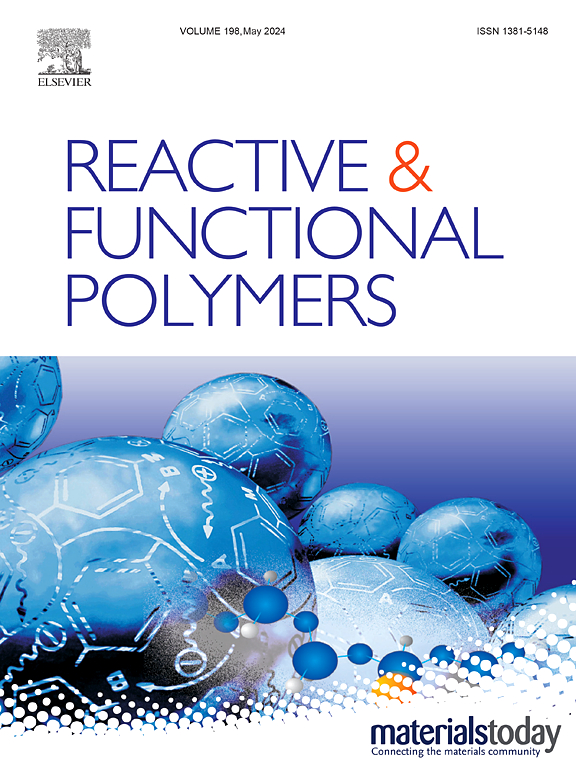多功能交联聚(离子液体)凝胶纳米复合材料用于环境修复,可持续能源生产和抗菌应用
IF 5.1
3区 工程技术
Q1 CHEMISTRY, APPLIED
引用次数: 0
摘要
制备了一系列PIL凝胶基纳米复合材料,并对其在环境修复、可持续能源生产和抗菌等方面的应用进行了表征和评价。该材料由聚(4-乙烯基吡啶)由二溴化PEG或PCL交联组成,在凝胶网络中留下il样部分作为交联节点。然后,将这些材料作为载体,通过吸附/还原法合成Au和Pt纳米颗粒(NPs)。采用FT-IR、TGA、DSC、NMR和HRTEM等技术对复合材料进行了表征。交联剂的选择对材料的溶胀和吸附性能有很大影响。与PIL-PCL凝胶相比,由于PEG的亲水性,PIL-PEG体系具有更高的溶胀率和更快的金属吸收速度。基于AuNPs/ pil的材料可以通过吸附和转化为4-氨基酚来去除水源中的4NP,这一反应被用作环境修复模型。在连续运行中,该工艺的收率超过82%,也表现出显著的可回收性,没有催化剂实体从载体上解吸。另一方面,携带PtNPs的纳米复合材料能够将氨硼烷水解成氢,作为生成能量矢量分子的模型反应,保留了4NP去除过程中显示的特性,如高效(转化为氢95%以上),在三个反应循环中具有良好的可重用性和稳定性。最后,凝胶中可电离单元的存在使材料具有抗菌性能,从而显著降低细菌活力,提高系统在应用环境中的耐久性。本文章由计算机程序翻译,如有差异,请以英文原文为准。

Versatile crosslinked poly(ionic liquid) gel nanocomposites for environmental remediation, sustainable energy generation and antibacterial applications
A series of PIL gel-based nanocomposites were obtained, characterized and evaluated for relevant applications such as environmental remediation, sustainable energy generation and antibacterial applications. The materials consisted of poly(4-vinyl pyridine) crosslinked by dibrominated PEG or PCL, leaving IL-like moieties that act as crosslinking nodes within the gel network. Afterwards, the materials were employed as supports for the synthesis of Au and Pt nanoparticles (NPs) via an adsorption/reduction approach. The hybrid materials were characterized by FT-IR, TGA, DSC, NMR and HRTEM techniques. The selection of the crosslinker showed a considerable effect on the swelling and adsorption properties of the materials. Compared with the PIL-PCL gels, the PIL-PEG systems presented higher swelling ratios and faster metal uptake because of the hydrophilicity of PEG. AuNPs/PIL-based materials can remove 4NP from water sources, via adsorption and conversion into 4-aminophenol, a reaction used as an environmental remediation model. The process took place with yields above 82 % in successive runs, also exhibiting a remarkable recyclability, with no desorption of catalytic entities from the support. On the other hand, nanocomposites bearing PtNPs were capable of hydrolysing ammonia borane into hydrogen, as a model reaction for the generation of energy vector molecules, conserving the properties revealed during 4NP removal, like high effectiveness (conversion into hydrogen above 95 %), proper reusability and stability during three reaction cycles. Finally, the presence of ionizable units in the gel endows the material with antimicrobial properties, allowing a significant reduction in bacterial viability, enhancing system durability in the environments where it may be applied.
求助全文
通过发布文献求助,成功后即可免费获取论文全文。
去求助
来源期刊

Reactive & Functional Polymers
工程技术-高分子科学
CiteScore
8.90
自引率
5.90%
发文量
259
审稿时长
27 days
期刊介绍:
Reactive & Functional Polymers provides a forum to disseminate original ideas, concepts and developments in the science and technology of polymers with functional groups, which impart specific chemical reactivity or physical, chemical, structural, biological, and pharmacological functionality. The scope covers organic polymers, acting for instance as reagents, catalysts, templates, ion-exchangers, selective sorbents, chelating or antimicrobial agents, drug carriers, sensors, membranes, and hydrogels. This also includes reactive cross-linkable prepolymers and high-performance thermosetting polymers, natural or degradable polymers, conducting polymers, and porous polymers.
Original research articles must contain thorough molecular and material characterization data on synthesis of the above polymers in combination with their applications. Applications include but are not limited to catalysis, water or effluent treatment, separations and recovery, electronics and information storage, energy conversion, encapsulation, or adhesion.
 求助内容:
求助内容: 应助结果提醒方式:
应助结果提醒方式:


